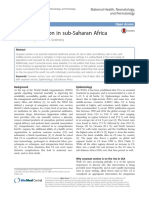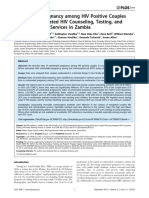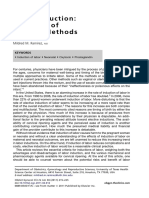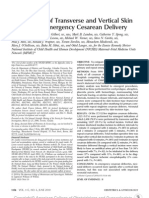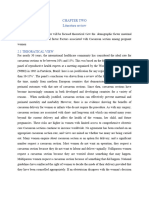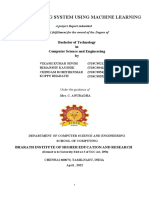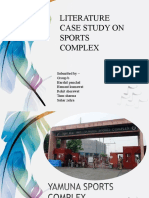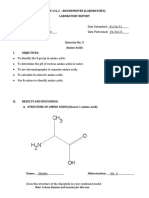Effect of A Text Messaging-Based Educational Intervention On Cesarean Section Rates Among Pregnant Women in China: Quasirandomized Controlled Trial
Effect of A Text Messaging-Based Educational Intervention On Cesarean Section Rates Among Pregnant Women in China: Quasirandomized Controlled Trial
Uploaded by
forensik24mei koasdaringCopyright:
Available Formats
Effect of A Text Messaging-Based Educational Intervention On Cesarean Section Rates Among Pregnant Women in China: Quasirandomized Controlled Trial
Effect of A Text Messaging-Based Educational Intervention On Cesarean Section Rates Among Pregnant Women in China: Quasirandomized Controlled Trial
Uploaded by
forensik24mei koasdaringOriginal Description:
Original Title
Copyright
Available Formats
Share this document
Did you find this document useful?
Is this content inappropriate?
Copyright:
Available Formats
Effect of A Text Messaging-Based Educational Intervention On Cesarean Section Rates Among Pregnant Women in China: Quasirandomized Controlled Trial
Effect of A Text Messaging-Based Educational Intervention On Cesarean Section Rates Among Pregnant Women in China: Quasirandomized Controlled Trial
Uploaded by
forensik24mei koasdaringCopyright:
Available Formats
JMIR MHEALTH AND UHEALTH Su et al
Original Paper
Effect of a Text Messaging–Based Educational Intervention on
Cesarean Section Rates Among Pregnant Women in China:
Quasirandomized Controlled Trial
Yanfang Su1*, SCD; Jesse Heitner2*, SCD; Changzheng Yuan3,4*, SCD; Yafei Si5, MA; Dan Wang6, MA; Zhiying
Zhou7, MA; Zhongliang Zhou6, PhD
1
School of Medicine, University of Washington, Seattle, WA, United States
2
Aceso Global, Washington, DC, United States
3
The Children’s Hospital and School of Public Health, Zhejiang University School of Medicine, Hangzhou, China
4
Nutrition Department, Harvard School of Public Health, Boston, MA, United States
5
School of Risk & Actuarial Studies and Centre of Excellence in Population Ageing Research (CEPAR), University of New South Wales, Sydney,
Australia
6
School of Public Policy and Administration, Xi’an Jiaotong University, Xi'an, China
7
School of Public Health, Xi’an Jiaotong University Health Science Center, Xi'an, China
*
these authors contributed equally
Corresponding Author:
Zhongliang Zhou, PhD
School of Public Policy and Administration
Xi’an Jiaotong University
28# Xianning West Road
Xi'an
China
Phone: 86 18291498261
Email: zzliang1981@xjtu.edu.cn
Abstract
Background: Consensus exists that appropriate regional cesarean rates should not exceed 15% of births, but China’s cesarean
rate exceeds 50% in some areas, prompting numerous calls for its reduction. At present, China’s 2016 two-child policy has
heightened the implications of national cesarean section trends.
Objective: This study leveraged pervasive cellular phone access amongst Chinese citizens to test the effect of a low-cost and
scalable prenatal advice program on cesarean section rates.
Methods: Participants were pregnant women presenting for antenatal care at a clinic in Xi’an, China. Assignment was
quasirandomized and utilized factorial assignment based on the expecting mother’s birthday. Participants were assigned to one
of the following four groups, with each receiving a different set of messages: (1) a comparison group that received only a few
“basic” messages, (2) a group receiving messages primarily regarding care seeking, (3) a group receiving messages primarily
regarding good home prenatal practices, and (4) a group receiving text messages of all groups. Messages were delivered throughout
pregnancy and were tailored to each woman’s gestational week. The main outcome was the rates of cesarean delivery reported
in the intervention arms. Data analysts were blinded to treatment assignment.
Results: In total, 2115 women completed the trial and corresponding follow-up surveys. In the unadjusted analysis, the group
receiving all texts was associated with an odds ratio of 0.77 (P=.06), though neither the care seeking nor good home prenatal
practice set yielded a relevant impact. Adjusting for potentially confounding covariates showed that the group with all texts sent
together was associated with an odds ratio of 0.67 (P=.01). Notably, previous cesarean section evoked an odds ratio of 11.78
(P<.001), highlighting that having a cesarean section predicts future cesarean section in a subsequent pregnancy.
Conclusions: Sending pregnant women in rural China short informational messages with integrated advice regarding both
care-seeking and good home prenatal practices appears to reduce women’s likelihood of undergoing cesarean section. Reducing
clear medical indications for cesarean section seems to be the strongest potential pathway of the effect. Cesarean section based
https://mhealth.jmir.org/2020/11/e19953 JMIR Mhealth Uhealth 2020 | vol. 8 | iss. 11 | e19953 | p. 1
(page number not for citation purposes)
XSL• FO
RenderX
JMIR MHEALTH AND UHEALTH Su et al
on only maternal request did not seem to occur regularly in our study population. Preventing unnecessary cesarean section at
present may have a long-term impact on future cesarean section rates.
Trial Registration: ClinicalTrials.gov NCT02037087; https://clinicaltrials.gov/ct2/show/NCT02037087.
International Registered Report Identifier (IRRID): RR2-10.1136/bmjopen-2015-011016
(JMIR Mhealth Uhealth 2020;8(11):e19953) doi: 10.2196/19953
KEYWORDS
cesarean section; short message service; SMS text messaging; quasirandomized controlled trial; mobile health
demonstrated in numerous studies [14]. In a new pregnancy, a
Introduction prior CS may cause an increased risk of fetal wastage and may
The global health care community has estimated that regional be linked to unexplained stillbirth [10,14]. Further, there is a
cesarean section (CS) rates should not exceed 10% to 15% [1,2]. strong body of evidence on impaired uterine function following
However, in the Global Survey by the World Health cesarean delivery. In subsequent pregnancies, CS poses a risk
Organization (WHO), CS in China was estimated to involve of uterine scar dehiscence, and, in some cases, uterine rupture
46.2% of all deliveries, which is the highest rate for any country [14]. As of January 2016, China altered its one-child policy to
in the survey [3]. In a recent multicenter survey of 39 hospitals a two-child policy, suddenly making the effects of CS on
across mainland China, the overall CS rate was 54.90% [4]. It subsequent pregnancies a tremendously more important
is estimated that between 1990 and 2014, China had an average consideration.
annual rate of increase in CS of about 10%, and misconceptions Given the risks and benefits, the WHO has concluded that
of pain, genital modification, safety, and cultural fortune were “cesarean section should ideally only be undertaken when
reported as leading factors [5]. Since at least 2008, this increase medically necessary” [2]. Yet, Lumbiganon et al estimated that
was most visible in the rural counties of China [6]. Though rural 11.7% of all deliveries in China during their study period
counties have clearly lower rates of CS than general city or involved CS with no medical indications [3]. Combining the
“supercity” areas, as of 2014, the average rural county CS rate 24 countries in the Global Survey by the WHO, it was estimated
was slightly over 30%, and it is rising [6]. that 63% of all CS procedures without medical indications were
When warranted, CS is a vital intervention. Many studies have performed in China [11]. An important driver of this pattern is
confirmed that it has a strong protective effect on perinatal that women with no indications necessitating CS frequently
mortality when conditions, such as breech presentation, placenta request this procedure. Cesarean delivery on maternal request
previa, and uterine rupture, are encountered [3,7,8]. A study of accounted for 15.53% of all deliveries and 28.43% of all
66,226 deliveries in Shanghai found that compared with vaginal cesarean deliveries in a multicenter survey [4]. This national
delivery, CS was associated with a reduction in antepartum estimate confirms what at least 11 other smaller and qualitative
stillbirth, bone trauma, intracranial hemorrhage, and neonatal studies [15] and at least one regional estimate [16] have
hypoxemic encephalopathy [9]. Moreover, studies suggest no suggested (women’s preferential choices are part of the rise in
evidence of a difference in maternal mortality between planned China’s CS rates). Influencing this demand may be an important
vaginal and planned cesarean delivery [10]. In the Global Survey strategy for reducing medically unnecessary CS.
by the WHO, the maternal mortality risk for antepartum CS There is also evidence that part of the “demand” for CS is
without an indication could not be estimated because there were supplier induced [17]. CS brings in approximately double the
no maternal deaths in the group [3]. However, CS does come hospital revenue per birth as compared with vaginal delivery
with serious risks [8]. Using data from the Global Survey by [16,18], and the power imbalance between patients and providers
the WHO, although researchers found no association with may mask the true decision making [14,15]. In a recent study
maternal mortality, CS without medical indications had strong in Shanghai, of 599 women interviewed in their third trimester,
associations with severe maternal morbidity. On putting death 17.0% reported preferring cesarean delivery. Yet, among women
and several severe morbidities, namely admission to the completing the study, 58.1% underwent CS. Of those, only
intensive care unit, blood transfusion, and hysterectomy, into 50.0% had clinically accepted indications for CS [19]. Therefore,
one “Severe Maternal Outcomes” index, the authors found that educating and empowering women to refute inappropriate doctor
elective antepartum CS had an adjusted odds ratio (OR) of 5.93 recommendations for CS may be as important of a pathway for
(CI 3.88-9.05) for qualifying for the index and elective reducing CS as changing women’s underlying preferences.
intrapartum CS had an adjusted OR of 14.29 (CI 10.91-18.72)
(both P<.05) [11]. A large cohort study in Australia found that There is agreement that the rate of CS in China, whether supply
mothers delivering via CS were more likely to be readmitted to or demand-side driven, is excessive, and experts are calling for
the hospital within 8 weeks of birth [12]. strategies for its reduction [1,4,17]. Mobile health (mHealth)
generally has already shown relevant effects in several
CS is also associated with problems after delivery. A recent intervention areas. However, evidence for or against its efficacy
study found that women delivering via CS had roughly twice for maternal and child health is scarce [20,21], and larger scale
the odds of persistent pain 1 year after delivery [13]. The evaluations of its possible effects are warranted [22-27]. This
association between CS and reduced future fertility has been study comprises a portion of the Evaluation for mHealth
https://mhealth.jmir.org/2020/11/e19953 JMIR Mhealth Uhealth 2020 | vol. 8 | iss. 11 | e19953 | p. 2
(page number not for citation purposes)
XSL• FO
RenderX
JMIR MHEALTH AND UHEALTH Su et al
Interventions’ Newborn Health Project. The Newborn Health sent 15 delivery-relevant messages, generally focusing on
Project has several aims, and its primary (trial registered) metric inspiring confidence in vaginal delivery and discussing
of success is a newborn’s appropriate weight for gestational age nonanesthetic ways to cope with pain during delivery. The “all
[28,29]. This study investigated whether the project was texts” group received 22 relevant messages composed of those
successful in the secondary goal of lowering the rate of CS in sent to the other treatment arms. The sent messages relevant to
the intervention arms. labor and delivery are presented in Multimedia Appendix 2.
Though presented in English there, all sent messages were in
Methods Mandarin.
The Newborn Health Project offers expectant mothers in the This study was approved by the Ethics Committee of the School
rural district of Gaoling in Xi’an, China, a package of free, short, of Medicine at Xi’an Jiaotong University on January 18, 2013,
informational messages regarding pregnancy and childbirth via and an updated version was approved on May 2016 (approval
cell phones. The full protocol of the Newborn Health Project number: 2016-392). All women attending their first visit for
has been published elsewhere [29], including the process and antenatal care at Gaoling district’s local maternal and child
rationale for selecting the study site. The study utilizes factorial health center (MCHC) during the study period were invited to
quasirandomization at the individual level to assign women to participate if they were aged 18 to 45 years old and had access
receive one of four groups of text messages and then compares to a cellular phone within their household. All participants
outcomes between the four groups. Participating women were signed an informed consent form. Pilot testing with 140 subjects
blinded to assignment. All data analyses were performed with occurred between September and October 2013, and survey
blinding to treatment assignment. The trial has been registered questionnaires were finalized after incorporating feedback from
at ClinicalTrials.gov (NCT02037087). the testing. The participants included in our pilot were excluded
in our data analysis and causal inferences. Enrollment and data
The four study arms were as follows: (1) good home prenatal collection for the study were performed between November
practice messages (home practices), which included advice on 2013 and February 2016. Enrollment stopped before our power
nutrition, exercise, self-awareness of depression, breastfeeding, calculation–based sample size goals were reached in December
etc; (2) care-seeking messages (care seeking), which included 2015, when Gaoling MCHC stopped sending program texts
information about government-subsidized programs, warning after decided that future patient communications should
signs of potential problems, and the importance of care seeking preferably be sent over WeChat than cellular SMS text
during illness; (3) both types of messaging (all texts); and (4) messaging. It is extremely noteworthy that the contents of our
a very limited (25 in total) set of “basic” messages about SMS intervention could easily be sent via WeChat, but in
pregnancy (acting as a comparison group). Women in the other December 2015, the trial was not set up to do so.
intervention arms also received all of the basic messages. It was
decided that the comparison group should receive at least some At recruitment, prior to treatment assignment, a baseline survey
regular informational “placebo” messages to make the was conducted by a health worker at the local MCHC during
participants in this group feel like they received a service and the first antenatal visit. We collected demographic data,
were part of the program. Ethically, it also ensured that all self-reported health data, and data relating to each enrollee’s
enrollees received the most basic pregnancy information, which thoughts and perceptions regarding health during pregnancy
is the informational equivalent of “basic care.” These basic and childbirth. The follow-up survey was conducted by a health
messages primarily included updates on fetal development, as worker at the newborn’s home around 1 week after delivery.
well as reminders for prenatal visits and promotion of certified The follow-up survey collected information on knowledge,
skilled attendance of labor. Group comparisons of treatment psychological and behavioral changes, and pregnancy-related
arms elicited the effect of (assignment to) receiving the content maternal and neonatal measures. A final survey was conducted
in the intervention messages in addition to the basic ones, and by phone to assess postpartum depression around 1 month after
estimated this effect separated out from any effect associated delivery. Additionally, the final survey asked whether the
with being included in an informational messaging study. The enrollee had successfully received our messages.
number of messages by topic and study arm is presented in
Multimedia Appendix 1. Results
The four treatment arms received differing sets of messages Our program enrolled a total of 4629 women (Figure 1). In our
relevant to labor and delivery that could potentially impact a prior publication and Multimedia Appendix 3 [28], we present
woman’s choice of delivery mode. Of the “basic” (comparison) summary statistics and balance checks for all 55 measured
group’s 25 messages, none were relevant to delivery. The baseline covariates. As previously reported via these balance
“care-seeking” group was sent seven relevant messages, checks, we inferred that our quasirandomization was effective
generally focusing on describing proper indications for CS and in assigning treatment orthogonally to relevant observable
cautioning that CS and anesthesia make birth less painful but covariates.
come with their other risks. The “home practices” group was
https://mhealth.jmir.org/2020/11/e19953 JMIR Mhealth Uhealth 2020 | vol. 8 | iss. 11 | e19953 | p. 3
(page number not for citation purposes)
XSL• FO
RenderX
JMIR MHEALTH AND UHEALTH Su et al
Figure 1. CONSORT flow diagram: enrollment, allocation, follow-up, and analysis.
In total, 2115 women completed a postdelivery follow-up recognizable pregnancies end in spontaneous miscarriage within
survey, which could be linked to the baseline survey (Figure the first trimester [30]. As of 2010, China’s induced abortion
1). Among these, 526 (24.9%) were in the “basic” group, 518 rate was hovering steadily around 19.5% [31]. Rates of
(24.5%) in the care-seeking group, 497 (23.5%) in the home miscarriage and abortion were not collected as part of our trial,
practices group, and 574 (27.1%) in the all texts group. A but likely account for important shares of our loss to follow-up.
chi-square test failed to reject equal loss to follow-up at P=.44. Further, if women moved or otherwise gave birth outside of our
A balance check on all measured baseline characteristics was study catchment area or if the village health attendant was
performed restricted to the final 2115 women. Only one test otherwise unaware of a birth or unable to reach a new mother
rejected balance at P<.05, and a further three rejected balance at her home, the pregnant woman was lost to follow-up. Finally,
at .05<P<.10. We therefore inferred that among the women it was sometimes impossible to match follow-up surveys to
completing our study, our quasirandomization was effective in baseline surveys. This happened when women provided
assigning treatment orthogonally to observable covariates. This sufficiently different identifying information in the baseline and
set of balance checks is presented in Multimedia Appendix 4. follow-up surveys or when such information was sufficiently
misrecorded.
Loss to follow-up occurred via multiple pathways. First, only
women who delivered their children, including stillbirths, were The unadjusted rates of cesarean delivery by treatment
available for analysis regarding mode of delivery. This analysis assignment are presented in Table 1. The largest difference was
was inapplicable for any woman who miscarried or underwent between the “basic” group and the “all texts” group, whose rate
an abortion after enrollment. About 15% of clinically was lower by 5.2 percentage points.
https://mhealth.jmir.org/2020/11/e19953 JMIR Mhealth Uhealth 2020 | vol. 8 | iss. 11 | e19953 | p. 4
(page number not for citation purposes)
XSL• FO
RenderX
JMIR MHEALTH AND UHEALTH Su et al
Table 1. Cesarean section numbers, rates, and odds ratios by treatment assignment, among women who reported delivery mode.
Group Women who completed fol- Women who report- Vaginal deliveries, n Cesarean sections, n Cesarean, odds ratio
low-up survey, n ed delivery mode, n (%)
Basic 526 522 372 150 (28.7) Base case
Care Seeking 518 515 379 136 (26.4) 0.88
Home Practices 497 494 >369 >125 (25.3) 0.84
All Texts 574 >570 >436 >134 (23.5) >0.77
Total 2115 2101 1556 545 (25.9) N/Aa
a
N/A: not applicable.
Only 2101 of 2115 women reported their mode of delivery A second model, also presented in Table 2, included all baseline
(Figure 1). Some missingness is to be expected in any large-scale covariates found to be unbalanced at P<.10 for either the full
survey, and no variable measured had all 2115 responses. It has sample or for the 2115 subjects who completed the study.
been shown that a process called “multiple imputation” using Adding these unbalanced covariates had negligible effect on
expectation maximization will generally outperform the most regression results. The P value on assignment to the all texts
common general techniques of handling missing data [32]. Thus, group reached .048, but accounting for multiple comparisons
multiple imputation was performed in R (R Foundation for left this finding not statistically significant. One noteworthy
Statistical Computing) using the Amelia package. This process finding is that having a previous miscarriage was strongly
imputed 16 data sets that had “complete” data on all variables predictive of undergoing CS at our study site, with an associated
of interest, allowing all 2115 observations to be used in OR of 1.37 (95% CI 1.12-1.68). Whether the mechanism of this
regression analysis. All regression analyses were run once per association is physiological or psychological may be an area
imputed data set, and the results were combined using the Rubin for future study.
technique for combining quantities of interest [32].
As a further robustness check, a third logistic regression model
Four regression models were run to explore the impact of (Model 3) was run, which contained all unbalanced baseline
treatment on CS rates. Model 1 is an unadjusted logistic covariates as well as an array of baseline general health,
regression of the (log) odds of having CS on indicators for maternal, socioeconomic, and health psychology covariates that
assignment to each intervention arm, with the “basic” arm might influence or predict birth via CS. These results are also
omitted as the base case. Results are presented in Table 2. presented in Table 2. The health psychology covariates (not
shown) attempted to account for the major constructs of the
In Model 1, neither the “care-seeking” group nor the “home
most widely cited theories of health behavior, namely the health
practices” group alone was associated with a statistically
belief model, social cognitive theory, theory of planned
significant reduction in the odds of undergoing CS (P=.37 and
behavior, theory of reasoned action, and trans-theoretical model
P=.21, respectively). In combination, the all texts group was
[33-35].
associated with an OR of 0.77, but the P value was .06.
https://mhealth.jmir.org/2020/11/e19953 JMIR Mhealth Uhealth 2020 | vol. 8 | iss. 11 | e19953 | p. 5
(page number not for citation purposes)
XSL• FO
RenderX
JMIR MHEALTH AND UHEALTH Su et al
Table 2. Logistic regression analysis of cesarean birth according to treatment assignment.
Model Odds ratio 95% CI P value
Model 1: Unadjusted logistic regression
Treatment assignment
Basic only Base case N/Aa N/A
Care seeking 0.88 0.67-1.16 .37
Good home practices 0.84 0.63-1.11 .21
All texts 0.77 0.59-1.01 .06
Model 2b: Adjusted logistic regression for imbalance
Treatment assignment
Basic only Base case N/A N/A
Care seeking 0.87 0.66-1.14 .32
Good home practices 0.82 0.62-1.08 .16
All texts 0.76 0.58-1.00 .048
Model 3c: Adjusted logistic regression for all
Treatment assignment
Basic only Base case N/A N/A
Care seeking 0.75 0.54-1.04 .08
Good home practices 0.77 0.56-1.07 .12
All texts 0.67 0.49-0.92 .01
a
N/A: not applicable.
b
Model 2 adjusted for all unbalanced baseline covariates.
c
Model 3 adjusted for all unbalanced baseline covariates as well as an array of baseline general health, maternal, socioeconomic, and health psychology
covariates (Multimedia Appendix 4).
These additional covariates noticeably strengthened the possibility that preventing unnecessary CS now may have a
measured effect of assignment to each treatment arm. The OR direct and long-term impact on future CS rates.
for the care-seeking group fell from 0.87 to 0.75, the OR for
As mentioned, the postdelivery survey also inquired whether
the home practice group fell from 0.82 to 0.77, and the OR for
the enrollees had actually received text messages from the
the all texts group fell from 0.76 to 0.67. The P values on
Newborn Health Project during pregnancy. Surprisingly, of the
assignment to the first two groups remained above traditional
2115 participants, only 1627 (76.93%) answered “Yes,” 459
significance (P=.08 and P=.12 respectively), but that of
(21.70%) reported not receiving messages from the study, and
assignment to the all text group dropped to P=.01, which
29 (1.37%) did not respond to that question. A final model was
remained statistically significant under the Bonferroni method
run with the same unadjusted functional form as Model 1, but
of correcting for multiple testing of three tests in the same
limited to participants who answered “Yes” or were imputed
regression.
to have answered “Yes.” The results are displayed in Table 3.
Most of the magnitude of these changes can be accounted for
It is unknown why 459 of the 2115 participants (21.70%)
by the addition of two variable sets (analysis not shown),
reported not receiving messages from the study. Nonexclusive
including whether the woman previously had CS (OR 11.8,
possibilities include phone numbers being miswritten on the
95% CI 7.2-19.3) and indicators for her stated preferred mode
survey, phone numbers being misentered into the SMS delivery
of delivery during enrollment. Preferring CS over vaginal birth
system, participant phone numbers changing after enrollment,
and feeling unsure are both associated with about twice the odds
participants giving numbers beside their text-enabled cellular
of CS (OR 2.0, 95% CI 1.3-3.2 and OR 2.0, 95% CI 1.4-2.9,
numbers as requested, and recall error.
respectively). Intriguingly, this equality implies that feeling
“unsure” carries the same effect as actually preferring CS, This subset that reported receiving this study’s texts displayed
perhaps implicating a strong supply-side nudge toward CS for a stronger unadjusted intervention effect than that for all study
uncertain women. An enormously pressing implication of Model participants. In this subset (Figure 1), the all texts group was
3 is that if a woman has CS in one pregnancy, she is vastly more associated with a highly significant reduction in the odds of
likely to have one in any subsequent pregnancy, raising the undergoing CS (OR 0.66, P=.008).
https://mhealth.jmir.org/2020/11/e19953 JMIR Mhealth Uhealth 2020 | vol. 8 | iss. 11 | e19953 | p. 6
(page number not for citation purposes)
XSL• FO
RenderX
JMIR MHEALTH AND UHEALTH Su et al
Table 3. Logistic regression analysis of cesarean birth according to treatment assignment (women who reported text receipt).
Treatment assignment (unadjusted logistic regression) Odds ratio 95% CI P value
Basic only Base case N/Aa N/A
Care seeking 0.76 0.55-1.04 .09
Good home practices 0.80 0.58-1.09 .12
All texts 0.66 0.49-0.90 .008
a
N/A: not applicable.
There was an unadjusted increase in the probability of delivering
Discussion via CS of 54 percentage points, from about 27% probability
External Validity among women without a previous CS to about 81% probability
given a previous CS. A previous CS is often considered its own
After adjusting for potentially confounding covariates, our main indication for CS and accounted for the largest difference
finding shows that the group with all texts sent together had an between the two groups, but women with a history of CS had
OR of 0.67 (P=.01). The rate of CS in the basic (comparison) more CS procedures for every single reason category. The
group of our study (28.7% between 2013 and 2016) is identical percentages in Figure 2 were derived from compiling the
to that in a study in rural Shaanxi, China in 2018 [36] and is imputed “complete” data sets. The raw unimputed data had a
well representative of (slightly lower than) the typical rural smaller sample but indicated an even more stark difference in
county rate of just over 30% in China in 2014, which was group rates of CS. Because of this strong association, we
reported by Li et al [6]. Nonetheless, it is roughly double the hypothesize that CS history could act as an effect modifier for
WHO’s recommended rate of 10% to 15%, and merits our SMS intervention, but we were not powered to test this
improvement. One possible reason for this disparity is that our hypothesis directly. Therefore, we present in Multimedia
sample came from an MCHC in a rural area. It has been Appendix 5 the stated reasons for CS by intervention group
estimated that women in large cities in China have 2.4 times only for those women with no stated history of CS, accounting
the odds of CS as compared with women in smaller cities [37]. for about 87% of our sample. For convenience, Multimedia
Further, Liu et al found that CS rates increased with hospital Appendix 6 presents the same data in terms of each arm’s
complexity, with tertiary care facilities having the highest rates differences from the “basic” texts group.
[4]. Thus, our findings are likely to be most closely replicated
in rural areas of China, but may be well indicative of such CS based only on maternal request was not a common
counties. occurrence in our sample (Figure 2). Stated reasons for CS that
were not a medical indication accounted for less than 5% of CS
Potential Pathways cases (26/548 cases) in our sample. This left our intervention
Our informational texts had several hypothesized pathways by very little room to affect CS by reducing cesarean delivery on
which they might impact mode of delivery, including (1) altering maternal request, though the “other/not specified” category may
women’s underlying preferences, (2) empowering women to or may not be comprised largely of maternal requests.
decline doctor-suggested CS by increasing their knowledge and Multimedia Appendix 6 shows that reducing clear medical
self-efficacy, and/or (3) reducing the number of legitimate indications for CS seems to be the strongest potential pathway
indications for CS. Our follow-up survey asked women who for our texts to have had an effect, with this category showing
delivered via CS why they did so, and investigating their the largest reduction in all treatment groups. The
responses shed some light on how our intervention may have provider-induced “doctor-suggested” category had mixed
been effective. Due to the very strong association between a evidence, being reduced in the “all texts” group but ostensibly
reported previous CS and mode of delivery, we first present increased in the individual “care-seeking” or “home practices”
responses broken down by CS history in Figure 2. group.
https://mhealth.jmir.org/2020/11/e19953 JMIR Mhealth Uhealth 2020 | vol. 8 | iss. 11 | e19953 | p. 7
(page number not for citation purposes)
XSL• FO
RenderX
JMIR MHEALTH AND UHEALTH Su et al
Figure 2. Reasons for current cesarean section (CS) delivery by CS history.
China had 16.55 million new births [38]. With the recent
Limitations relaxations in China’s one-child policy, this number could grow
Our study has several limitations. First, women self-reported considerably in the next few years. Given the risk that
their delivery method to health workers. If our intervention unnecessary CS poses and the current excessive amount in
induced a belief that vaginal delivery was a more socially China, wider distribution of the Newborn Health Project’s
desirable answer than CS, CS could be underreported in messages on delivery mode seems to be a strategy worth trying.
intervention arms. Second, our study population was The acceptability and effectiveness of WeChat as a mode of
concentrated in a single county. It is unknown how results would delivering such messages also warrant scientific exploration.
differ in other settings. Finally, high loss to follow-up lowered
the planned statistical power of our study. Attrition does not Conclusions
seem to be associated with treatment assignment, and baseline A quasirandomized controlled trial distributing informational
covariates were balanced within both the full sample and the text messages to pregnant women in Gaoling, China found
subset that completed the study, which suggests that loss to evidence that the full set of text messages may have reduced
follow-up did not bias our results. However, we cannot measure the number of cesarean deliveries in that group by 5.2 percentage
whether it is associated with the mode of delivery, and as such, points compared with the comparison group. Focusing on the
we cannot confidently rule out the possibility that high attrition subset of women who reported actually receiving program texts
altered our findings. and adjusting for baseline covariates greatly strengthened this
measured relationship. Given the numerous calls for strategies
Implications to reduce the rate of medically unnecessary CS in China,
As a first of its kind, this evaluation breaks ground in the fields exploration of the wider distribution of these text messages
of SMS text messaging for maternal health in China and SMS seems warranted.
text messaging for influencing the mode of delivery. In 2015,
Acknowledgments
We would like to thank our implementation team members from Xi’an Jiaotong University. We are also grateful for all the support
from leaders and health workers in the local collaborating organizations in Gaoling and Lantian. The authors would like to thank
Drs David Canning, Till Bärnighausen, and Margaret McConnell for feedback on this manuscript. This study was made possible
with generous funding from the UBS Optimus Foundation and B&P Foundation. The funders had no role in the study except
providing financial support.
https://mhealth.jmir.org/2020/11/e19953 JMIR Mhealth Uhealth 2020 | vol. 8 | iss. 11 | e19953 | p. 8
(page number not for citation purposes)
XSL• FO
RenderX
JMIR MHEALTH AND UHEALTH Su et al
Authors' Contributions
Yan S as the Project Director for the team led designing the intervention and study, led literature review, and detailed the method
of program evaluation. JH participated in literature review, participated in development of survey questionnaires regarding
psychological and behavioral measurements, led the data analysis, and led drafting of the manuscript. CY helped design the study,
participated in literature review, and led the development of the text messages and survey questionnaires. Ya S, DW, and Zhi Z
assisted in implementation, data entry, and data cleaning. Zho Z helped design the study and led the implementation of the project.
All authors have made significant intellectual or practical contributions. All authors critically revised the manuscript and approved
the final version of this paper.
Conflicts of Interest
None declared.
Multimedia Appendix 1
SMS text messages by general topic, treatment group, and timing.
[PDF File (Adobe PDF File), 87 KB-Multimedia Appendix 1]
Multimedia Appendix 2
Messages regarding delivery advice by treatment arm.
[PDF File (Adobe PDF File), 120 KB-Multimedia Appendix 2]
Multimedia Appendix 3
Balance check and all baseline variables: all enrollees.
[PDF File (Adobe PDF File), 405 KB-Multimedia Appendix 3]
Multimedia Appendix 4
Balance check and all baseline variables: women with follow-up surveys.
[PDF File (Adobe PDF File), 404 KB-Multimedia Appendix 4]
Multimedia Appendix 5
Reasons for current cesarean section delivery by SMS intervention assignment (N=2104).
[PDF File (Adobe PDF File), 11 KB-Multimedia Appendix 5]
Multimedia Appendix 6
Differences in reasons for current cesarean section delivery by SMS intervention assignment.
[PDF File (Adobe PDF File), 11 KB-Multimedia Appendix 6]
Multimedia Appendix 7
CONSORT-EHEALTH checklist (V 1.6.1).
[PDF File (Adobe PDF File), 2716 KB-Multimedia Appendix 7]
References
1. Vogel J, Betrán AP, Vindevoghel N, Souza J, Torloni M, Zhang J, WHO Multi-Country Survey on MaternalNewborn
Health Research Network. Use of the Robson classification to assess caesarean section trends in 21 countries: a secondary
analysis of two WHO multicountry surveys. Lancet Glob Health 2015 May;3(5):e260-e270 [FREE Full text] [doi:
10.1016/S2214-109X(15)70094-X] [Medline: 25866355]
2. WHO Statement on Caesarean Section Rates Internet. World Health Organization. 2015. URL: http://apps.who.int/iris/
bitstream/10665/161442/1/WHO_RHR_15.02_eng.pdf [accessed 2020-10-25]
3. Lumbiganon P, Laopaiboon M, Gülmezoglu A, Souza J, Taneepanichskul S, Ruyan P, et al. Method of delivery and
pregnancy outcomes in Asia: the WHO global survey on maternal and perinatal health 2007–08. The Lancet 2010
Feb;375(9713):490-499 [FREE Full text] [doi: 10.1016/s0140-6736(09)61870-5]
4. Liu Y, Li G, Chen Y, Wang X, Ruan Y, Zou L, et al. A descriptive analysis of the indications for caesarean section in
mainland China. BMC Pregnancy Childbirth 2014 Dec 12;14:410 [FREE Full text] [doi: 10.1186/s12884-014-0410-2]
[Medline: 25495550]
https://mhealth.jmir.org/2020/11/e19953 JMIR Mhealth Uhealth 2020 | vol. 8 | iss. 11 | e19953 | p. 9
(page number not for citation purposes)
XSL• FO
RenderX
JMIR MHEALTH AND UHEALTH Su et al
5. Betrán AP, Ye J, Moller A, Zhang J, Gülmezoglu AM, Torloni M. The Increasing Trend in Caesarean Section Rates: Global,
Regional and National Estimates: 1990-2014. PLoS One 2016;11(2):e0148343-e0142014 [FREE Full text] [doi:
10.1371/journal.pone.0148343] [Medline: 26849801]
6. Li H, Luo S, Trasande L, Hellerstein S, Kang C, Li J, et al. Geographic Variations and Temporal Trends in Cesarean
Delivery Rates in China, 2008-2014. JAMA 2017 Jan 03;317(1):69-76. [doi: 10.1001/jama.2016.18663] [Medline: 28030701]
7. Villar J, Carroli G, Zavaleta N, Donner A, Wojdyla D, Faundes A, World Health Organization 2005 Global Survey on
MaternalPerinatal Health Research Group. Maternal and neonatal individual risks and benefits associated with caesarean
delivery: multicentre prospective study. BMJ 2007 Nov 17;335(7628):1025 [FREE Full text] [doi:
10.1136/bmj.39363.706956.55] [Medline: 17977819]
8. American College of ObstetriciansGynecologists (College), Society for Maternal-Fetal Medicine, Caughey AB, Cahill AG,
Guise JM, Rouse DJ. Safe prevention of the primary cesarean delivery. Am J Obstet Gynecol 2014 Mar;210(3):179-193.
[doi: 10.1016/j.ajog.2014.01.026] [Medline: 24565430]
9. Liu X, Landon MB, Cheng W, Chen Y. Cesarean delivery on maternal request in China: what are the risks and benefits?
Am J Obstet Gynecol 2015 Jun;212(6):817.e1-817.e9 [FREE Full text] [doi: 10.1016/j.ajog.2015.01.043] [Medline:
25640048]
10. Visco AG, Viswanathan M, Lohr KN, Wechter ME, Gartlehner G, Wu JM, et al. Cesarean Delivery on Maternal Request.
2006;108(6):1517-1529. [doi: 10.1097/01.aog.0000241092.79282.87]
11. Souza J, Gülmezoglu AM, Lumbiganon P, Laopaiboon M, Carroli G, Fawole B, WHO Global Survey on MaternalPerinatal
Health Research Group. Caesarean section without medical indications is associated with an increased risk of adverse
short-term maternal outcomes: the 2004-2008 WHO Global Survey on Maternal and Perinatal Health. BMC Med 2010
Nov 10;8:71-7015 [FREE Full text] [doi: 10.1186/1741-7015-8-71] [Medline: 21067593]
12. Thompson J, Roberts C, Currie M, Ellwood D. Prevalence and persistence of health problems after childbirth: associations
with parity and method of birth. Birth 2002 Jun;29(2):83-94 [FREE Full text] [doi: 10.1046/j.1523-536x.2002.00167.x]
[Medline: 12051189]
13. Kainu J, Sarvela J, Tiippana E, Halmesmäki E, Korttila K. Persistent pain after caesarean section and vaginal birth: a cohort
study. Int J Obstet Anesth 2010 Jan;19(1):4-9 [FREE Full text] [doi: 10.1016/j.ijoa.2009.03.013] [Medline: 19733050]
14. Gilliam M. Cesarean delivery on request: reproductive consequences. Semin Perinatol 2006 Oct;30(5):257-260. [doi:
10.1053/j.semperi.2006.07.005] [Medline: 17011396]
15. Feng XL, Wang Y, An L, Ronsmans C. Cesarean section in the People's Republic of China: current perspectives. Int J
Womens Health 2014;6:59-74 [FREE Full text] [doi: 10.2147/IJWH.S41410] [Medline: 24470775]
16. Zhang J, Liu Y, Meikle S, Zheng J, Sun W, Li Z. Cesarean delivery on maternal request in southeast China. Obstet Gynecol
2008 May;111(5):1077-1082. [doi: 10.1097/AOG.0b013e31816e349e] [Medline: 18448738]
17. Huang C, Wu H, Huang S, Chien L, Guo J. Transtheoretical model-based passive smoking prevention programme among
pregnant women and mothers of young children. Eur J Public Health 2013 Oct 15;23(5):777-782 [FREE Full text] [doi:
10.1093/eurpub/cks177] [Medline: 23325124]
18. Mi J, Liu F. Rate of caesarean section is alarming in China. The Lancet 2014 Apr;383(9927):1463-1464 [FREE Full text]
[doi: 10.1016/s0140-6736(14)60716-9]
19. Ji H, Jiang H, Yang L, Qian X, Tang S. Factors contributing to the rapid rise of caesarean section: a prospective study of
primiparous Chinese women in Shanghai. BMJ Open 2015 Nov 13;5(11):e008994-e008994. [doi:
10.1136/bmjopen-2015-008994] [Medline: 26567254]
20. Noordam A, Kuepper B, Stekelenburg J, Milen A. Improvement of maternal health services through the use of mobile
phones. Trop Med Int Health 2011 May;16(5):622-626 [FREE Full text] [doi: 10.1111/j.1365-3156.2011.02747.x] [Medline:
21342374]
21. Tamrat T, Kachnowski S. Special delivery: an analysis of mHealth in maternal and newborn health programs and their
outcomes around the world. Matern Child Health J 2012 Jul;16(5):1092-1101. [doi: 10.1007/s10995-011-0836-3] [Medline:
21688111]
22. Evans WD, Wallace JL, Snider J. Pilot evaluation of the text4baby mobile health program. BMC Public Health 2012 Nov
26;12(1):1031 [FREE Full text] [doi: 10.1186/1471-2458-12-1031] [Medline: 23181985]
23. Jareethum R, Titapant V, Chantra T, Sommai V, Chuenwattana P, Jirawan C. Satisfaction of healthy pregnant women
receiving short message service via mobile phone for prenatal support: A randomized controlled trial. J Med Assoc Thai
2008 Apr;91(4):458-463. [Medline: 18556852]
24. Lund S, Hemed M, Nielsen B, Said A, Said K, Makungu M, et al. Mobile phones as a health communication tool to improve
skilled attendance at delivery in Zanzibar: a cluster-randomised controlled trial. BJOG 2012 Sep;119(10):1256-1264 [FREE
Full text] [doi: 10.1111/j.1471-0528.2012.03413.x] [Medline: 22805598]
25. Naughton F, Jamison J, Sutton S. Attitudes towards SMS text message smoking cessation support: a qualitative study of
pregnant smokers. Health Educ Res 2013 Oct 02;28(5):911-922 [FREE Full text] [doi: 10.1093/her/cyt057] [Medline:
23640985]
https://mhealth.jmir.org/2020/11/e19953 JMIR Mhealth Uhealth 2020 | vol. 8 | iss. 11 | e19953 | p. 10
(page number not for citation purposes)
XSL• FO
RenderX
JMIR MHEALTH AND UHEALTH Su et al
26. Tang S, Ghose B, Hoque MR, Hao G, Yaya S. Women Using Mobile Phones for Health Communication Are More Likely
to Use Prenatal and Postnatal Services in Bangladesh: Cross-Sectional Study. JMIR Mhealth Uhealth 2019 Feb 28;7(2):e10645
[FREE Full text] [doi: 10.2196/10645] [Medline: 30816850]
27. Hussain T, Smith P, Yee LM. Mobile Phone-Based Behavioral Interventions in Pregnancy to Promote Maternal and Fetal
Health in High-Income Countries: Systematic Review. JMIR Mhealth Uhealth 2020 May 28;8(5):e15111 [FREE Full text]
[doi: 10.2196/15111] [Medline: 32463373]
28. Zhou Z, Su Y, Heitner J, Si Y, Wang D, Zhou Z, et al. The Effects on Inappropriate Weight for Gestational Age of an SMS
Based Educational Intervention for Pregnant Women in Xi'an China: A Quasi-Randomized Controlled Trial. Int J Environ
Res Public Health 2020 Feb 25;17(5):1482 [FREE Full text] [doi: 10.3390/ijerph17051482] [Medline: 32106558]
29. Su Y, Yuan C, Zhou Z, Heitner J, Campbell B. Impact of an SMS advice programme on maternal and newborn health in
rural China: study protocol for a quasi-randomised controlled trial. BMJ Open 2016 Aug 10;6(8):e011016. [doi:
10.1136/bmjopen-2015-011016] [Medline: 27515750]
30. Pannel VM. Miscarriages: Diagnosis, Management and Coping Strategies. Hauppauge, NY: Nova Science Publishers;
2014. URL: https://novapublishers.com/shop/miscarriages-diagnosis-management-and-coping-strategies/
31. Wang C. Induced abortion patterns and determinants among married women in China: 1979 to 2010. Reproductive Health
Matters 2014 Jun 04;22(43):159-168. [doi: 10.1016/s0968-8080(14)43753-4]
32. King G, Honaker J, Joseph A, Scheve K. Analyzing Incomplete Political Science Data: An Alternative Algorithm for
Multiple Imputation. Am Polit Sci Rev 2002 Mar 28;95(1):49-69 [FREE Full text] [doi: 10.1017/s0003055401000235]
33. de Jersey SJ. Are we missing opportunities? Understanding health behaviours associated with overweight in pregnancy.
QUT ePrints. 2013. URL: https://eprints.qut.edu.au/61090/ [accessed 2020-10-25]
34. Lippke S, Ziegelmann JP. Theory-based health behavior change: Developing, testing, and applying theories for evidence-based
interventions. Applied Psychology: An International Review 2008;57(4):698-716. [doi: 10.1111/j.1464-0597.2008.00339.x]
35. Noar SM, Zimmerman RS. Health Behavior Theory and cumulative knowledge regarding health behaviors: are we moving
in the right direction? Health Educ Res 2005 Jun;20(3):275-290 [FREE Full text] [doi: 10.1093/her/cyg113] [Medline:
15632099]
36. Zhang R, Li S, Li C, Zhao D, Guo L, Qu P, et al. Socioeconomic inequalities and determinants of maternal health services
in Shaanxi Province, Western China. PLoS One 2018;13(9):e0202129 [FREE Full text] [doi: 10.1371/journal.pone.0202129]
[Medline: 30183720]
37. Tang S, Li X, Wu Z. Rising cesarean delivery rate in primiparous women in urban China: evidence from three nationwide
household health surveys. Am J Obstet Gynecol 2006 Dec;195(6):1527-1532 [FREE Full text] [doi:
10.1016/j.ajog.2006.03.044] [Medline: 16677593]
38. China's Economy Realized a Moderate but Stable and Sound Growth in 2015. National Bureau of Statistics of China. 2016.
URL: http://www.stats.gov.cn/english/PressRelease/201601/t20160119_1306072.html [accessed 2020-10-25]
Abbreviations
CS: cesarean section
MCHC: maternal and child health center
mHealth: mobile health
OR: odds ratio
WHO: World Health Organization
Edited by G Eysenbach; submitted 07.05.20; peer-reviewed by P Fontelo, E Luo; comments to author 20.08.20; revised version
received 12.09.20; accepted 22.09.20; published 03.11.20
Please cite as:
Su Y, Heitner J, Yuan C, Si Y, Wang D, Zhou Z, Zhou Z
Effect of a Text Messaging–Based Educational Intervention on Cesarean Section Rates Among Pregnant Women in China:
Quasirandomized Controlled Trial
JMIR Mhealth Uhealth 2020;8(11):e19953
URL: https://mhealth.jmir.org/2020/11/e19953
doi: 10.2196/19953
PMID: 33141099
©Yanfang Su, Jesse Heitner, Changzheng Yuan, Yafei Si, Dan Wang, Zhiying Zhou, Zhongliang Zhou. Originally published in
JMIR mHealth and uHealth (http://mhealth.jmir.org), 03.11.2020. This is an open-access article distributed under the terms of
the Creative Commons Attribution License (https://creativecommons.org/licenses/by/4.0/), which permits unrestricted use,
https://mhealth.jmir.org/2020/11/e19953 JMIR Mhealth Uhealth 2020 | vol. 8 | iss. 11 | e19953 | p. 11
(page number not for citation purposes)
XSL• FO
RenderX
JMIR MHEALTH AND UHEALTH Su et al
distribution, and reproduction in any medium, provided the original work, first published in JMIR mHealth and uHealth, is
properly cited. The complete bibliographic information, a link to the original publication on http://mhealth.jmir.org/, as well as
this copyright and license information must be included.
https://mhealth.jmir.org/2020/11/e19953 JMIR Mhealth Uhealth 2020 | vol. 8 | iss. 11 | e19953 | p. 12
(page number not for citation purposes)
XSL• FO
RenderX
You might also like
- Sectio in AfricaDocument10 pagesSectio in AfricaagilNo ratings yet
- Bai bao 11Document6 pagesBai bao 11bonhwavnNo ratings yet
- Prevalence and Risk Factors of Severe Postpartum Hemorrhage - A Retrospective Cohort StudyDocument8 pagesPrevalence and Risk Factors of Severe Postpartum Hemorrhage - A Retrospective Cohort StudyAdel GameliNo ratings yet
- Scientrfic Basis For The Content of Routine Antenatal CareDocument14 pagesScientrfic Basis For The Content of Routine Antenatal CareRusdySpotrNo ratings yet
- Menu Script For The ReasearchDocument9 pagesMenu Script For The ReasearchHrithik SureshNo ratings yet
- 9 PDFDocument9 pages9 PDFAnggun SetiawatiNo ratings yet
- 34neha EtalDocument3 pages34neha EtaleditorijmrhsNo ratings yet
- Integration of Postpartum Healthcare Services ForDocument31 pagesIntegration of Postpartum Healthcare Services ForYulian elleNo ratings yet
- Jurnal 3Document10 pagesJurnal 3Dyah Ayu NNo ratings yet
- P ('t':'3', 'I':'670968655') D '' Var B Location Settimeout (Function ( If (Typeof Window - Iframe 'Undefined') ( B.href B.href ) ), 15000)Document10 pagesP ('t':'3', 'I':'670968655') D '' Var B Location Settimeout (Function ( If (Typeof Window - Iframe 'Undefined') ( B.href B.href ) ), 15000)Septi RahadianNo ratings yet
- Evidence Based: Vaginal Birth After Cesarean: First ResearchDocument2 pagesEvidence Based: Vaginal Birth After Cesarean: First ResearchGodfrey AntolinNo ratings yet
- Prevalence and Associated Factors of Infertility Among 20-49 Year Old Women in Henan Province, ChinaDocument13 pagesPrevalence and Associated Factors of Infertility Among 20-49 Year Old Women in Henan Province, ChinaRaqqi PujatmikoNo ratings yet
- RPPH 16 32Document32 pagesRPPH 16 32forensik24mei koasdaringNo ratings yet
- Increase Ovarian, Uterine CancerDocument14 pagesIncrease Ovarian, Uterine Cancerirwan junNo ratings yet
- Unintended Pregnancy Among HIV PDFDocument11 pagesUnintended Pregnancy Among HIV PDFTitin JuherniNo ratings yet
- A Retrospective Study of Maternal and Perinatal Outcome in Patients of Postpartum Haemorrhage in A Tertiary Care HospitalDocument5 pagesA Retrospective Study of Maternal and Perinatal Outcome in Patients of Postpartum Haemorrhage in A Tertiary Care HospitalAdzana Yasadhy Hangga PrasetyoNo ratings yet
- Lit Review NealeDocument9 pagesLit Review Nealeapi-726948535No ratings yet
- To Ignore or Not To Ignore Placental Calcifications On Prenatal Ultrasound: A Systematic Review and Meta-AnalysisDocument22 pagesTo Ignore or Not To Ignore Placental Calcifications On Prenatal Ultrasound: A Systematic Review and Meta-AnalysisMaulida HalimahNo ratings yet
- Jurnal AnemiaDocument9 pagesJurnal AnemiasagitaftrNo ratings yet
- Association of Self-Reported Adherence and AntiretDocument2 pagesAssociation of Self-Reported Adherence and AntiretDavidNo ratings yet
- Delays in Receiving Obstetric Care and Poor Maternal Outcomes: Results From A National Multicentre Cross-Sectional StudyDocument15 pagesDelays in Receiving Obstetric Care and Poor Maternal Outcomes: Results From A National Multicentre Cross-Sectional Studykaren paredes rojasNo ratings yet
- Laborinduction: Areviewof Currentmethods: Mildred M. RamirezDocument11 pagesLaborinduction: Areviewof Currentmethods: Mildred M. RamirezRolando DiazNo ratings yet
- Articulo de Tarea Grupo Seguridad VialDocument10 pagesArticulo de Tarea Grupo Seguridad VialAlexander ZapataNo ratings yet
- Journal Pone 0180524 PDFDocument19 pagesJournal Pone 0180524 PDFNuke YolandaNo ratings yet
- WHO Statement On Caesarean Section Rates: Executive SummaryDocument9 pagesWHO Statement On Caesarean Section Rates: Executive SummaryNanaNo ratings yet
- Association Between Fetal Macrosomia and Risk of Obesity in Children Under 3 Years in Western China: A Cohort StudyDocument8 pagesAssociation Between Fetal Macrosomia and Risk of Obesity in Children Under 3 Years in Western China: A Cohort StudySayuri BenitesNo ratings yet
- Maternal Morbidity Associated With Multiple Repeat Cesarean DeliveriesDocument7 pagesMaternal Morbidity Associated With Multiple Repeat Cesarean Deliveriesdewi wahyuniNo ratings yet
- Women's Health Care Physicians: Member Login Join Pay Dues Follow UsDocument24 pagesWomen's Health Care Physicians: Member Login Join Pay Dues Follow UsNazif Aiman IsmailNo ratings yet
- Feto-Maternal Outcomes Following Caesarean SectionDocument6 pagesFeto-Maternal Outcomes Following Caesarean Sectionkirandhami1520No ratings yet
- Obstetric Fistula 2015 PDFDocument86 pagesObstetric Fistula 2015 PDFRakha Sulthan Salim100% (1)
- Does Timing of Antenatal Care Initiation and The CDocument8 pagesDoes Timing of Antenatal Care Initiation and The CFikaduNo ratings yet
- Clinicians and Mothers Decision On Caeserean Section RevisedDocument34 pagesClinicians and Mothers Decision On Caeserean Section RevisedHoly Family NMTC Library, BerekumNo ratings yet
- Abortion, Stillbirth, Miscarriage in Ghana-1Document10 pagesAbortion, Stillbirth, Miscarriage in Ghana-1brijitcujoNo ratings yet
- Safe Prevention of The Primary Cesarean Delivery - ACOGDocument16 pagesSafe Prevention of The Primary Cesarean Delivery - ACOGAryaNo ratings yet
- Psikologi PerkembanganDocument11 pagesPsikologi PerkembanganliaNo ratings yet
- 2016 Article 154Document7 pages2016 Article 154كنNo ratings yet
- Emergency Contraception: Knowledge and Attitudes of Family Physicians of A Teaching Hospital, Karachi, PakistanDocument6 pagesEmergency Contraception: Knowledge and Attitudes of Family Physicians of A Teaching Hospital, Karachi, PakistanNaveed AhmadNo ratings yet
- SoniaDocument10 pagesSonianurul hidayahNo ratings yet
- NIH Public Access: Author ManuscriptDocument14 pagesNIH Public Access: Author ManuscriptRafael FigueroaNo ratings yet
- Pone 0054858 PDFDocument7 pagesPone 0054858 PDFfiameliaaNo ratings yet
- Management of Hepatitis B Infected Pregnant Women: A Cross-Sectional Study of ObstetriciansDocument7 pagesManagement of Hepatitis B Infected Pregnant Women: A Cross-Sectional Study of Obstetricianslina ukagoNo ratings yet
- Risk Factors Associated With Caesarean Sections Compared With NorDocument12 pagesRisk Factors Associated With Caesarean Sections Compared With Norمي عديسانNo ratings yet
- Long-Acting Reversible Contraceptive Use in the Post-Abortion Period Among Women Seeking Abortion in Mainland ChinaDocument9 pagesLong-Acting Reversible Contraceptive Use in the Post-Abortion Period Among Women Seeking Abortion in Mainland ChinaTopaz Mulia abadiNo ratings yet
- PDF CJMB 208Document7 pagesPDF CJMB 208Maroua DidaneNo ratings yet
- Comparison of Transverse and Vertical Skin Incision For Emergency Cesarean DeliveryDocument7 pagesComparison of Transverse and Vertical Skin Incision For Emergency Cesarean DeliveryGinecólogo Oncólogo Danilo Baltazar ChaconNo ratings yet
- Jurnal HivDocument9 pagesJurnal Hivsheva25No ratings yet
- Female Sterilization by Tubal Ligation During C-Se PDFDocument5 pagesFemale Sterilization by Tubal Ligation During C-Se PDFYø KåiNo ratings yet
- Clinical Oncology: World Journal ofDocument13 pagesClinical Oncology: World Journal ofMATEJ MAMICNo ratings yet
- LONG-TERM PHYSICAL AND PSYCHOLOGICAL HEALTH CONSEQUENCES OF INDUCED ABORTION - A REVIEW OF THE EVIDENCEDocument31 pagesLONG-TERM PHYSICAL AND PSYCHOLOGICAL HEALTH CONSEQUENCES OF INDUCED ABORTION - A REVIEW OF THE EVIDENCEmarquinhos91No ratings yet
- March 30Document4 pagesMarch 30Hanisha EricaNo ratings yet
- Contemporary Cesarean Delivery Practice in The United StatesDocument17 pagesContemporary Cesarean Delivery Practice in The United StatesdedypurnamaNo ratings yet
- The Effect of A Training Program During Pregnancy On The Attitude and Intention of NulliparousDocument8 pagesThe Effect of A Training Program During Pregnancy On The Attitude and Intention of NulliparousNoraNo ratings yet
- 1-s2.0-S1896112619300252-mainDocument4 pages1-s2.0-S1896112619300252-mainsipasipapasi31No ratings yet
- Adverse Birth Outcomes Women With ‘ - LoDocument12 pagesAdverse Birth Outcomes Women With ‘ - Loshubh cards bhilwara Wedding cardsNo ratings yet
- Article1379671073 - Olugbenga-Bello Et AlDocument8 pagesArticle1379671073 - Olugbenga-Bello Et AlAmalia RiaNo ratings yet
- Chapter TwoDocument7 pagesChapter Twohanixasan2002No ratings yet
- Ces 1 Global EpidemiologyDocument8 pagesCes 1 Global EpidemiologyXIMENAGILDANo ratings yet
- Pone 0053747 PDFDocument11 pagesPone 0053747 PDFAkmad Ali AbdulNo ratings yet
- Lectura 2Document6 pagesLectura 2Luciano ArrunáteguiNo ratings yet
- Contraception for the Medically Challenging PatientFrom EverandContraception for the Medically Challenging PatientRebecca H. AllenNo ratings yet
- Section C - Group 6 Kshitij Yash H21145 - Lakshmi Venkatesh H21146 - Meghna Puri H21147 - Mohan Krishna Yalla H21148 - Shashwat Krishna H21166Document2 pagesSection C - Group 6 Kshitij Yash H21145 - Lakshmi Venkatesh H21146 - Meghna Puri H21147 - Mohan Krishna Yalla H21148 - Shashwat Krishna H21166SHASHWAT KRISHNANo ratings yet
- 103 - Padyamchollal - Arabic: Result:LP GeneralDocument6 pages103 - Padyamchollal - Arabic: Result:LP GeneralakgsghssNo ratings yet
- What Are The Interpretations and Implications From Exhibit 1 of The Case Study?Document2 pagesWhat Are The Interpretations and Implications From Exhibit 1 of The Case Study?Saurabh Kulkarni 23No ratings yet
- Crop Prediction System Final ReportDocument46 pagesCrop Prediction System Final ReportHimanshu KaushikNo ratings yet
- I - Imperial Knights ErrataDocument2 pagesI - Imperial Knights ErrataAnotherFlyGuyNo ratings yet
- Three-Phase Shortcircuit Synchronous MachinesDocument15 pagesThree-Phase Shortcircuit Synchronous MachinesJavierNo ratings yet
- MP Board Class 12 Physics I234 2018Document11 pagesMP Board Class 12 Physics I234 2018pathanrashid372No ratings yet
- Unit 03 - Future Contract - Principle of Future ContractDocument6 pagesUnit 03 - Future Contract - Principle of Future ContractAugusto SaavedraNo ratings yet
- Cash Box Top Singles 2 - 04 - 50Document2 pagesCash Box Top Singles 2 - 04 - 50David SkidgelNo ratings yet
- WET PCB Fabrication ProcessDocument14 pagesWET PCB Fabrication Processwebip33713100% (1)
- HPLC Column Catalog 2014 2015Document180 pagesHPLC Column Catalog 2014 2015Rafid FarhanNo ratings yet
- Team 4 Project - Target CorporationDocument23 pagesTeam 4 Project - Target CorporationLauren ChristineNo ratings yet
- BIMA BBS RegisterDocument47 pagesBIMA BBS Registeraminamin.200029No ratings yet
- Masterlist of Private Sec. Schools S.Y. 2016 2017 Cavite ProvinceDocument12 pagesMasterlist of Private Sec. Schools S.Y. 2016 2017 Cavite ProvinceRojohn ValenzuelaNo ratings yet
- Baking Tools and Equipment and Their UsesDocument2 pagesBaking Tools and Equipment and Their UsesEeyyaa0% (1)
- Review of Related Literature and Related StudyDocument9 pagesReview of Related Literature and Related StudyJustine Latorre MoraldeNo ratings yet
- Suresh ResumeDocument4 pagesSuresh ResumeskatnekaNo ratings yet
- Case Solutions For Case Studies in Finance Managing For Corporate Value Creation 6th Edition by BrunerDocument12 pagesCase Solutions For Case Studies in Finance Managing For Corporate Value Creation 6th Edition by Brunerbiwithse7en0% (1)
- 5th Sem / Branch: Computer Engg. Sub.: Cloud ComputingDocument2 pages5th Sem / Branch: Computer Engg. Sub.: Cloud Computingtrisha12062002No ratings yet
- ACON - SFF TransceiverDocument1 pageACON - SFF TransceiverClaudiney BricksNo ratings yet
- Cs101 Final PaperDocument9 pagesCs101 Final PaperTahir IftikharNo ratings yet
- Tertiary Geology of Part of South Makran, Baluchistan, West PakistanDocument20 pagesTertiary Geology of Part of South Makran, Baluchistan, West PakistanShakeel MirwaniNo ratings yet
- Rovalve SB 1700 SST Knife Gate Valve 2 - 24 InchDocument4 pagesRovalve SB 1700 SST Knife Gate Valve 2 - 24 InchCapacitacion TodocatNo ratings yet
- Placer DepositsDocument10 pagesPlacer DepositsS Hashim RizviNo ratings yet
- Industry Gap Valuation What-If Analysis (Power of One)Document12 pagesIndustry Gap Valuation What-If Analysis (Power of One)Pooja Smita NarjareeNo ratings yet
- Operating Manual-For GD450-sDocument29 pagesOperating Manual-For GD450-sTelapia Maach100% (1)
- Case Study-1Document67 pagesCase Study-1Sahar ZehraNo ratings yet
- TCVN 6260-2009 - Portland Blended Cement (E)Document4 pagesTCVN 6260-2009 - Portland Blended Cement (E)Long Lê100% (1)
- Laboratory Outline - Exercise 5Document6 pagesLaboratory Outline - Exercise 5Majestic RavenNo ratings yet
- 2008 - Evolution of Interest Rate Curve - Empirical Analysis of Patterns Using Nonlinear Clustering ToolsDocument9 pages2008 - Evolution of Interest Rate Curve - Empirical Analysis of Patterns Using Nonlinear Clustering ToolsFranck DernoncourtNo ratings yet
